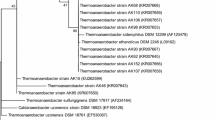Abstract
Thiobacillus thiooxidans DSM 504 was shown to grow with adenine, hypoxanthine, xanthine and uric acid as sole sources of nitrogen. Growth with these compounds was observed after lag periods of varying lengths, unless the cells had been previously grown with the same purine base. The disappearance of adenine was accompanied by a temporary accumulation of hypoxanthine in the medium. The utilization of purines was inhibited by ammonia (1 mM). Guanine, pyrimidines and some other organic compounds were not utilized.
Similar content being viewed by others
Abbreviations
- U-14C:
-
uniformly labeled by 14C
References
Barton LL, Shively JM (1968) Thiosulfate utilization by Thiobacillus thiooxidans ATCC 8085. J Bacteriol 95:720
Beudeker RF, Riegman R, Kuenen JG (1982) Regulation of nitrogen assimilation of the obligate chemolithotroph Thiobacillus neapolitanus. J Gen Microbiol 128:39–47
Boehringer (1976) Testfibel. Boehringer Mannheim, GmbH, Diagnostika, Mannheim
Brierley JA, Brierley CL (1968) Urea as a nitrogen source of Thiobacilli. J Bacteriol 96:573
Butler RG, Umbreit WW (1966) Absorption and utilization of organic matter by the strict autotroph, Thiobacillus thiooxidans, with special reference to aspartic acid. J Bacteriol 91:661–666
Eschmann K, Kaltwasser H (1982) Purine uptake by Alcaligenes eutrophus H 16. Arch Microbiol 131:191–196
Harrison AP (1984) The acidophilic thiobacilli and other acidophilic bacteria that share their habitat. Ann Rev Microbiol 38:265–292
Holdeman LV, Cato EP, Moore WEC (1977) Anaerobe laboratory manual, 4th edn, Anaerobe laboratory. Virginia Polytechnic Institute and State University Blacksburg, Virginia
Horsch W, Wolf B (1985) Harnstoff: Eine Übersicht unter besonderer Berücksichtigung seiner pharmazeutischen Verwendung and Analytik. Pharmazie 40:665–676
Lang E, Lang H (1972) Spezifische Farbreaktionen zum direkten Nachweis der Ameisensäure. Fresenius Z Anal Chem 260:8–10
Loring HS (1955) Hydrolysis of nucleic acids and procedures for the direct estimation of purine and pyrimidine fractions by adsorption spectrophotometry. In: Chargaff E, Davidson JN (eds). The nucleic acids, vol 1. Academic Press, New York, p 202
Manning HL (1975) New medium for isolating iron oxidising and heterotrophic acidophilic bacteria from acid mine drainage. Appl Microbiol 30:1010–1016
Matin A (1978) Organic nutrition of chemolithotrophic bacteria. Ann Rev Microbiol 32:433–468
Moore RB, Kauffmann NJ (1970) Simultaneous determination of citrulline and urea using diacetylmonoxime. Anal Biochem 33:263–272
Takakuwa S, Nishiwaki T, Hosoda K, Tominaga N, Iwasaki H (1977) Promoting effect of molybdate on the growth of a sulfur-oxidizing bacterium, Thiobacillus thiooxidans. J Gen Appl Microbiol 23:163–173
Trijbels F, Vogels (1966) Degradation of allantoin by Pseudomonas acidovorans. Biochim Biophys Acta 113:292–301
Vogels GD, Van der Drift C (1976) Degradation of purines and pyrimidines by microorganisms. Bacteriol Rev 40:403–468
Author information
Authors and Affiliations
Rights and permissions
About this article
Cite this article
Metzdorf, N., Kaltwasser, H. Utilization of organic compounds as the sole source of nitrogen by Thiobacillus thiooxidans . Arch. Microbiol. 150, 85–88 (1988). https://doi.org/10.1007/BF00409722
Received:
Accepted:
Issue Date:
DOI: https://doi.org/10.1007/BF00409722



